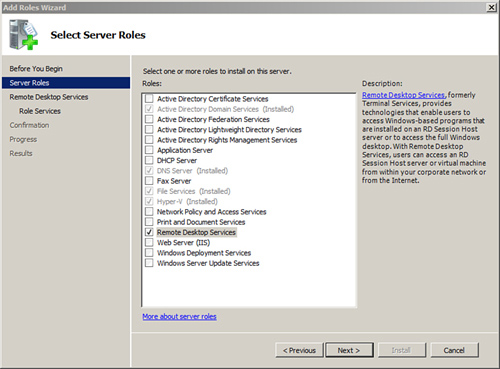Remote Desktop Services (RDS)
in Windows Server 2008 R2 enables users to access remote applications,
or even full Windows desktops. A central RD Session Host server hosts
the Windows applications, and clients are able to run the applications
remotely.
The primary command-line command you need to know when working with RDS is the change command. When installing some applications, you must be able to change the mode to install mode, and then back to execute mode.
Tip
RDS was previously known as Terminal Services. Microsoft changed the name to Remote Desktop Services in Windows Server 2008 R2.
Before these commands work, the RDS or Terminal
Services role must be installed. You can use the steps in the following
table to do so.
Note
These steps are written for both Windows Server 2008
and Windows Server 2008 R2. When there are differences, they are labeled
in the steps.
| Steps | Action |
|---|
| 1. | Launch Server Manager through the Administrative Tools menu. |
| 2. | Select Roles and click Add Roles. |
| 3. | Click Next on the Before You Begin page. |
| 4. | Windows Server 2008: Select the checkbox next to Terminal Services as shown in Figure 1.
Windows Server 2008 R2: Select the checkbox next to Remote Desktop Services as shown in Figure 31-2.
Click Next. |
| 5. | Review the information on the introduction screen and click Next. |
| 6. | Windows Server 2008: Select the checkbox next to Terminal Server.
Windows Server 2008 R2: Select the checkbox next to Remote Desktop Session Host.
Click Next. |
| 7. | Review the information about Application Compatibility and click Next. |
| 8. | Select the desired Authentication Method. Network Level Authentication is the most secure but older clients don’t support it. Click Next. |
| 9. | On the Specify Licensing Mode page, accept the default of Configure Later, and click Next. |
| 10. | On the User Groups page, you can add additional groups if desired. The Administrators group is added by default. Click Next. |
| 11. | Windows Server 2008 R2 only: Review the choices on the Configure Client Experience page. Select any features desired and click Next. |
| 12. | On the Confirmation page, click Install. When the install completes, click Close. Click Yes to restart the server. |
| 13. | After the system reboots, log on. The install wizard resumes and completes the installation. When it completes, click Close. |

